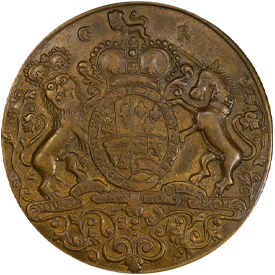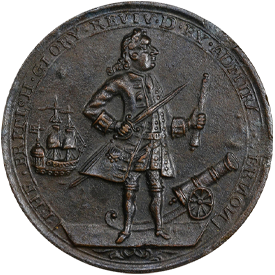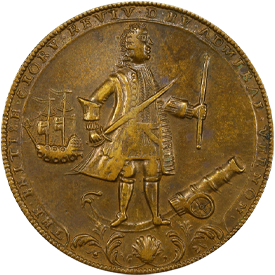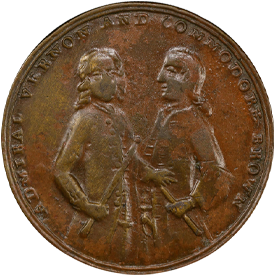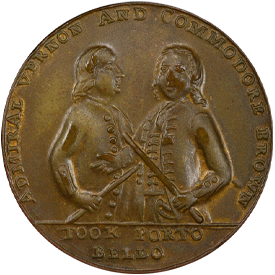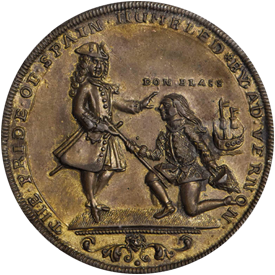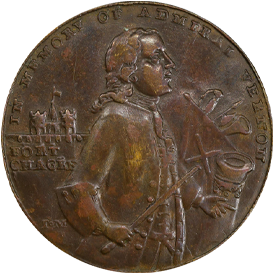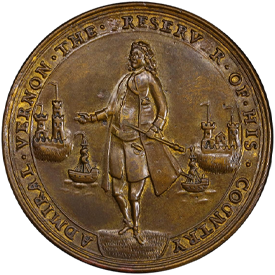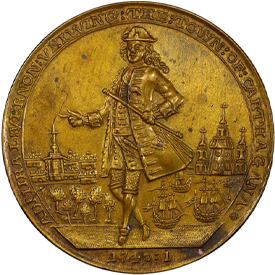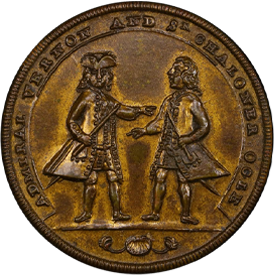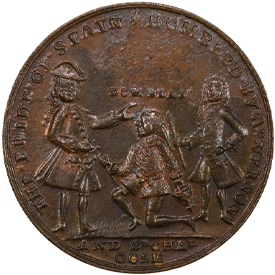The medals issued for sale to the public commemorating hero of the moment Admiral Edward Vernon and his foreign victories deserve to be better known. For this to happen, however, a new collector’s guide to the series will be needed. Vernons were described in Medallic Illustrations as well as in Betts but not in enough detail to make collecting them a challenge. Leander McCormick-Goodhart’s 1945 catalog was a monumental task but one that has left collectors with more difficult attributions than its author intended. Mr. John J. Ford, Jr. collected Vernons with little enthusiasm principally because McCormick-Goodhart was so hard to use. Nevertheless, his collection of Vernons was superb. The rarest pieces are the round ones in silver (or even silver plate) and the ovals. Mr. Ford had several of the former and one of the latter, which should be enough to suggest the importance of his collection.
In his introduction to the August 21, 1972 auction sale of an important collection of Vernon Medals, Alcedo Almanzar nicely summed up the strategic military reasons for Vernon's attack on Porto Bello in these (somewhat abridged) words: "Porto Bello is a seaport village on the Caribbean coast of Panama.. .For two centuries prior to 1739... Spanish galleons, filled with treasure from Vera Cruz, took shelter and refitted there before beginning the perilous return voyage across the ocean. Gold and silver bullion was brought to Porto Bello in cartloads for the purchase of European luxuries brought by the galleons from Spain. But, Porto Bello was also the base for Spanish gunboats which harassed merchant shipping of England and other nations. Spain actively asserted the right to search all vessels sailing to the British West Indies and of confiscating both ship and cargo. The merchants petitioned Parliament for years to no avail...Admiral Hosier, with twenty ships, made an unsuccessful attempt to capture Porto Bello in 1726. Thirteen years later, Vernon, then a member of Parliament, in a debate on Spanish aggression, declared that with six ships of the line he would take the place. England rang with his boast.. .On July 9, 1739 Vernon was made [Vice] Admiral of the Blue and on November 5 sailed for Porto Bello and, as if to carry out his boast, he took only six ships with him, leaving the remainder in Jamaica.”
No description of an 18th century naval action is as exciting to read as the one penned soon afterwards by or for the winning protagonist. Admiral Vernon’s successful engagement at Porto Bello was described in the March 15, 1740 issue of the London Gazette as follows:
“On Thursday last in the Evening Captain Rentone arrived here Express with Letters from Vice-Admiral Vernon, dated on board his Majesty’s Ship the Burford in Porto Bello Harbour, the 12th. of December last, to his Grace the Duke of Newcastle, his Majesty’s Principal Secretary of State, which gave the following Account.
On the 5th. November last Vice-Admiral Vernon sailed from Jamaica with his Majesty’s Ships the Burford, Hampton-Court, Princess Louisa, Worcester, Stratford, Norwich, and Sheerness, the last of which he ordered to cruise off Cartagena. On the 20th of November in the Evening he came in Sight of Porto-Bello, having been delayed in his Passage by contrary Winds. There being but little Wind that Evening, though a very great Swell, he anchored for that Night six Leagues off the Shore, being apprehensive of driving to the Eastward of the Harbour.

Plan of the Town of Porto Bello
On the 21st in the Morning, the Admiral plyed to Windward in Line of Battle, having given the proper Orders for the Attack, but the Wind proving Easterly, he was obliged to confine his Attack to the Iron Fort only, close to which the Squadron was piloted by Captain Rentone. Commodore Brown, in the Hampton-Court, who led the Attack, executed his Part, as became an Officer of Experience and Resolution, and being well followed by Captain Herbert in the Norwich, and Captain Mayne in the Worcester, the Admiral perceived that some of the Spaniards fled from several Parts of the Fort; upon which he made Signe for the Boats in which the Soldiers were, to make the best of their Way in order to their Landing, whilst he was coming up to the Fort to batter it. The Admiral luffing up as near to the Fort as he could, the Fire of his Small Arms commanded the Enemy’s lower Batteries, and had a good Effect in driving them from those Batteries, from which they could do most Harm; and by this Means the Men were also secured at Landing: And this (as the Enemy afterwards counselled) was the principal Occasion of their deserting the lower Batteries, the Small-shot from the former Ships not having reached them, though their Cannon had beat down some of the upper part of the Fort.
As the Boats came near the Admiral’s Ship, he called to them to go directly on Shore under the Walls of the Fort, tho’ there was no Breach made; but this answered as was expected, by throwing the Enemy into a general Consternation, the Officers and Men who had stood to the lower Battery flying to the upper Part of the Fort, where they held up a White Signal for Capitulating. The Admiral answered with a White Flag but it was some time before he could Stop his own Men, and those on board the Strafford, Captain Trevor, which followed him from Firing. In the mean time the Seamen had climb’d up the Walls of the lower Battery and struck the Colours and then drew the Soldiers up after them, to whom the Spaniards, who had retired to the upper Part of the Fort, soon after surrendered at Discretion. Their number was only five Officers and 35 Men, out of above 300, the rest being either killed or wounded, or having made their Escape. The Ships that went in before the Admiral were fallen to Leeward so as to be out of Sight of the Gloria Castle; but the Admiral’s Ship lying open to the said Castle, they kept on firing their longest guns at him till Night; but not being within Pointy-blank, their Shot either fell short, or went over him; only one Shot went through the Head of his Foretop-mast, just above the Rigging, so that it did no harm.
The Admiral finding they continued their Firing, tried some of his lower tier at them; which being new Guns, answered beyond Expectation, carrying over the Gloria Castle into the Town.
This successful Beginning was attended with very inconsiderable Loss, there being only three Men killed and five wounded on board the Admiral’s Ship; the like Number were killed and wounded on board the Worcester, and one Man had both his Legs shot off on board the Hampton-Court. The other Ships had none killed or wounded, and only two Soldiers were shot going ashore, one of which died soon after of his wounds.
The next morning, being the 22nd the Admiral went on board Commodore Brown, to call the Captains to consult together, and gave out the necessary Orders for warping the Ships up the next Night, in order to attack the Gloria Castle the Night following, as it would not have been practicable to attempt it in the Day-time. But in this he was prevented by the Enemy’s putting up a White Flag at the Gloria Castle, and sending a Boat with a Flag of Truce to the Admiral, with the Governor’s Adjutant, and a Lieutenant of a Man of War, who brought the Conditions signed on which they desired to capitulate.
As had been hoped, a considerable amount of booty was captured, including Ten thousand Dollars, that were arrived and designed for paying the King of Spain’s Troops at Porto Bello, falling into the Admiral’s Hands, he distributed them among his Majesty’s Forces for their Encouragement.”
Collecting Admiral Vernon Medals
As noted above, many collectors in the past have been intimidated by the sheer number and variety of medals relating to the exploits of Admiral Edward Vernon. C. Wyllys Betts encountered this problem in the 19th century and solved it to his own satisfaction by breaking the mass of material into five broad categories:
1) Medals of Vernon naming no event.
2) The capture of Porto Bello, Nov. 21-22, 1739.
3) The capture of Fort Chagre, March 24, 1740.
4) The capture of the outer forts of Cartagena, April 1, 1741.
5) The proposed attack on Havana, July 1741.
Betts subdivided the first category by obverse legend, providing further refinement out of this category’s seeming chaos:
a) Legends relating the fact of the capture of Porto Bello, bearing a Vernon bust.
b) Those proclaiming the revival of British Glory by Vernon, bearing a half-length Vernon portrait.
c) Legends adding the name of Commodore Brown to Vernon’s, two full- or half-length figures of Vernon and Brown.
d) Medals displaying Britain’s royal Arms on the obverse, a scene of the attack on Porto Bello on the reverse.
Perhaps the best approach to this complex series is for the collector to obtain the most pleasing examples possible of all the major types, and then enjoy fitting them into this basic organizing arrangement, then building on this basic outline as new examples join the growing collection.
The Admiral Vernon Betts Medals include Betts-171 to Betts-337.










